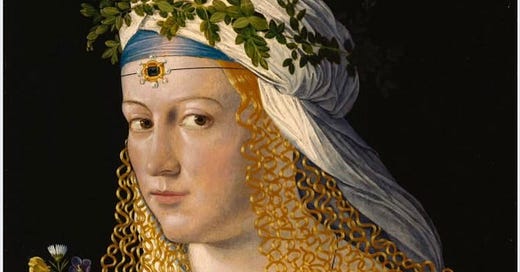Girls Just Want to Have Fun(ds): Renaissance Venice's Ultimate Boss Babe
Bartolomeo Veneto's Flora
In the early sixteenth century, when Venice glittered with both commerce and carnality, Bartolomeo Veneto painted a remarkable fusion of the sacred and profane. His Idealised Portrait of a Courtesan as Flora transforms a woman of the streets into the Roman goddess of spring and flowers—a metamorphosis as audacious as it is beautiful.
The painting pulses with contradiction. Here is Flora, deity of renewal and fertility, yet she wears the knowing gaze of Venice's most sophisticated courtesans. Veneto's brush captures both divinity and commerce, elevating his subject while acknowledging her trade. The flowers adorning her speak of Flora's mythological realm, but they also whisper of more earthly transactions—beauty bought and sold in the floating city.
This small tempera and oil panel, barely larger than a modern laptop screen, contains multitudes. It reflects Renaissance Venice's complex relationship with sexuality, where courtesans moved in the highest circles, their wit and beauty celebrated even as their profession remained marginal. Veneto gives his subject dignity through divine association, yet never quite lets us forget the world she inhabited.
The work stands as testament to an era when mythology served as both mirror and mask, allowing artists to explore the full spectrum of human experience while maintaining the necessary fiction of moral propriety. In transforming courtesan into goddess, Veneto achieved something remarkable: a portrait that is simultaneously idealized and unflinchingly real.




